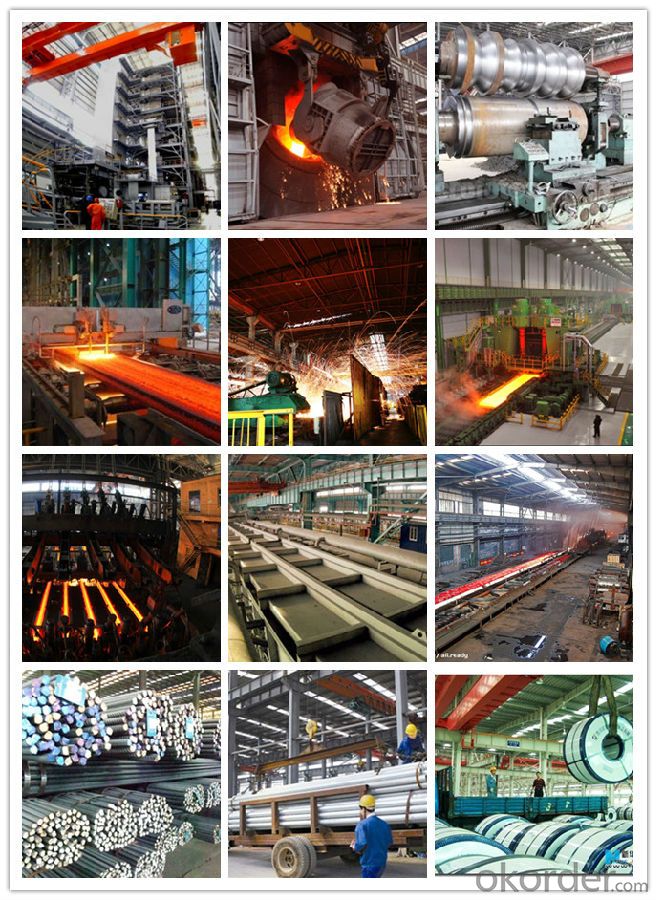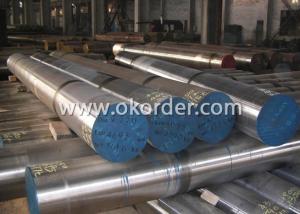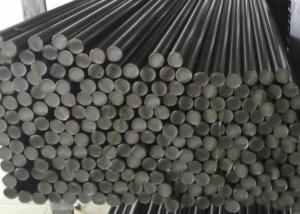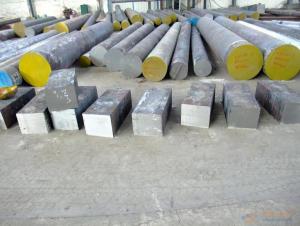Aisi 4140/42crmo4 Alloy Steel Round Bars
- Loading Port:
- China main port
- Payment Terms:
- TT or LC
- Min Order Qty:
- 25 m.t.
- Supply Capability:
- 10000 m.t./month
OKorder Service Pledge
OKorder Financial Service
You Might Also Like
Item specifice
Chemical composition in %:
C | Si | Mn | Cr | Mo | S |
0,38-0,45 | 0,10,0,40 | 0,60,0,90 | 0,90,1,20 | 0,15-0,30 | 0,020,0,040 |
Steel properties:
Grade of very common use, similar to 34 Cr Mo S 4, Cr Mp S 4, Steel grade 42 Cr Mo S 4 enables 100 MPa more to be achieved on the same sections than steel grade 34 Cr Mo S 4. Sometims used after surface hardening treatment.
Applications:
Parts for powertrain, shafts, press columns, axles of hydraulic jacks, pinions, annular gears,, bolting and screw rods for oil industry.
Mechanical properties:
Condition as supplied, annealed
Hardness: < 241 HB
condition as supplied, hardened and tempered
Ø | U.T.S. | Y.S.0.2% | Elongation | Elongation |
d < 16 | 1000-1300 | > 900 | > 10 | > 30 |
16 < 40 | 1000-1300 | > 750 | > 11 | > 35 |
40 < d < 100 | 900-1100 | > 650 | > 12 | > 35 |
100 < d < 160 | 800-950 | > 550 | > 13 | > 35 |
160 < d < 750 | 750-900 | > 500 | > 14 | > 35 |
250 < d < 500* | 690-840 | > 460 | > 15 | > 38** |
500 < d < 750* | 590-740 | > 390 | > 16 | > 38** |
Workshop show
Product show
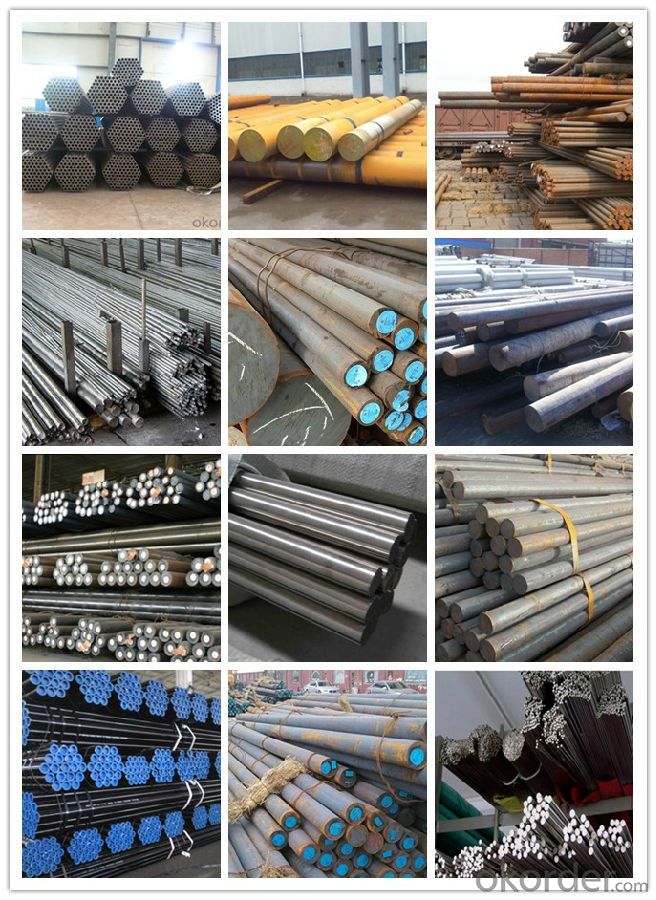
- Q:How does quenching and tempering affect the hardness of special steel?
- Special steel can have its hardness and mechanical properties improved through the use of heat treatment processes known as quenching and tempering. During quenching, the steel undergoes rapid cooling from a high temperature to either room temperature or below. This is typically achieved by immersing the steel in a quenching medium like oil or water. The quick cooling results in the formation of a martensitic structure, which is characterized by high hardness and brittleness. Quenching significantly enhances the hardness of the steel. However, the brittleness of the martensitic structure limits its usability in many applications. To address this issue, the steel then undergoes tempering. Tempering entails reheating the quenched steel to a temperature below the lower critical temperature, usually ranging from 200 to 600 degrees Celsius. The steel is held at this temperature for a specific period of time. This process facilitates the transformation of the brittle martensite into a more ductile structure known as tempered martensite. Tempering reduces the hardness of the steel but imparts improved toughness and ductility. The actual hardness achieved after tempering depends on the tempering temperature and time. Higher temperatures and longer times result in a greater reduction in hardness. By carefully adjusting the tempering parameters, a balance between hardness and toughness suitable for the intended application can be achieved. To summarize, quenching and tempering have a significant impact on the hardness of special steel. Quenching increases hardness by creating a martensitic structure, while tempering reduces hardness but enhances toughness and ductility. The specific hardness achieved through these processes can be controlled by adjusting the quenching and tempering parameters to meet the desired mechanical properties for the specific application.
- Q:How does special steel contribute to the manufacturing of cutting tools?
- Due to its unique properties and characteristics, special steel plays a crucial role in the manufacturing of cutting tools. Tool steel, also known as special steel, exhibits high hardness, enabling it to withstand the tremendous forces and stress exerted during cutting operations, preventing quick deformation or wear of the cutting tools and ensuring their longevity and efficiency. In addition, special steel possesses excellent wear resistance, minimizing the wear and tear on the tools subjected to constant friction and abrasion. This improves the tool's lifespan, reducing the need for frequent replacements and enhancing cost-effectiveness in the manufacturing process. Furthermore, special steel offers superior heat resistance, maintaining its hardness and integrity even under high temperatures. This allows cutting tools to perform consistently and precisely, even in extreme heat conditions, preventing thermal degradation and loss of hardness. Moreover, special steel used in cutting tool manufacturing exhibits excellent toughness and strength, enabling the tools to endure heavy loads and impacts without fracturing or chipping. The combination of hardness, wear resistance, heat resistance, toughness, and strength provided by special steel ensures the durability and reliability of cutting tools, allowing them to perform efficiently and accurately. Overall, special steel significantly contributes to the manufacturing of cutting tools, providing the necessary properties to withstand demanding cutting conditions. Its high hardness, wear resistance, heat resistance, toughness, and strength ensure that cutting tools remain sharp, durable, and efficient, enhancing productivity and precision in various industries, including automotive, aerospace, and manufacturing.
- Q:What are the different types of heat treatment processes used for special steel?
- The different types of heat treatment processes used for special steel include annealing, normalizing, hardening, tempering, and quenching.
- Q:What industries use special steel?
- Special steel plays a vital role in multiple industries, relying on its unique properties to carry out their operations. The automotive industry, for instance, utilizes special steel extensively in manufacturing engine parts, transmission systems, and chassis components. The exceptional strength, durability, and corrosion resistance of special steel make it an ideal choice for withstanding the challenging conditions faced by automotive components. Similarly, the aerospace industry heavily relies on special steel in constructing aircraft structures, engine components, and landing gear systems. The lightweight yet robust characteristics of special steel are crucial in ensuring the safety and performance of aircraft. In the energy sector, special steel is essential for producing equipment used in oil and gas exploration, such as drilling rigs, pipelines, and offshore platforms. The high-strength and corrosion-resistant properties of special steel enable it to withstand the harsh operating conditions prevalent in this industry. The construction industry is also a significant consumer of special steel, using it in the manufacturing of structural components, reinforcing bars, and precast concrete products. Special steel provides the necessary strength and durability required for building structures capable of withstanding diverse environmental conditions and heavy loads. Moreover, the manufacturing and machinery industry relies on special steel for producing heavy machinery, industrial equipment, and machine tools. The exceptional strength, wear resistance, and heat resistance properties of special steel make it well-suited to meet the demanding requirements of these applications. Lastly, the defense and military industry heavily depends on special steel for producing military vehicles, weapons, and armor. Special steel's ability to withstand extreme conditions and provide protection makes it a critical material in this industry. Overall, special steel's exceptional properties of strength, durability, corrosion resistance, and heat resistance make it indispensable across various industries. Its applications span from automotive and aerospace to energy, construction, manufacturing, and defense sectors, where reliability and performance are of paramount importance.
- Q:What are the specific requirements for special steel used in the nuclear waste storage industry?
- The specific requirements for special steel used in the nuclear waste storage industry include high corrosion resistance to withstand the harsh and corrosive environment of nuclear waste, excellent mechanical properties to maintain structural integrity over long periods of time, low susceptibility to radiation-induced embrittlement, and the ability to retain its properties even at elevated temperatures. Additionally, the steel must meet stringent standards for radiation shielding and must be able to prevent the release of radioactive materials into the environment.
- Q:How is special steel used in the defense industry?
- Special steel is used in the defense industry for various applications such as manufacturing armored vehicles, aircraft carriers, submarines, and military-grade firearms. Its exceptional strength, durability, and resistance to high temperatures make it ideal for constructing critical components and structures that require enhanced protection and performance in combat situations.
- Q:How does spring steel maintain its elasticity?
- Spring steel maintains its elasticity due to its unique composition and manufacturing process. It is made from a specific type of high-carbon steel that undergoes a specialized heat treatment called quenching and tempering. This process involves heating the steel to a high temperature and then rapidly cooling it in water or oil, followed by reheating to a specific temperature and allowing it to cool slowly. This heat treatment creates a fine-grained microstructure in the steel, which gives it the ability to withstand repeated bending or twisting without permanently deforming. Additionally, the high carbon content in spring steel enhances its strength and resilience, allowing it to return to its original shape even after being subjected to significant force or pressure.
- Q:How is special steel used in the textile industry?
- Special steel is used in the textile industry for various applications such as manufacturing textile machinery, fabricating cutting tools, and producing components for textile production processes. It provides the necessary strength, durability, and precision required to handle the high-speed and high-pressure operations involved in textile manufacturing.
- Q:What are the main characteristics of structural steel forgings?
- Structural steel forgings possess several key characteristics that make them ideal for various applications in construction and engineering. Firstly, one of the main characteristics of structural steel forgings is their exceptional strength and durability. Steel is known for its high tensile strength, which allows it to withstand heavy loads and resist deformation under stress. This makes structural steel forgings suitable for supporting large structures and withstanding dynamic forces such as wind or seismic activity. Another important characteristic is the versatility of structural steel forgings. Steel can be fabricated into a wide range of shapes and sizes, making it adaptable for different design requirements. It can be forged into complex shapes with intricate details, allowing for precise and customized components to be created. This versatility enables structural steel forgings to be used in a variety of applications, from beams and columns in buildings to bridges and offshore structures. Additionally, structural steel forgings have excellent weldability. Steel can be easily joined together using various welding techniques, allowing for the creation of strong and reliable connections. This enhances the overall structural integrity of steel components and ensures their longevity. Another key characteristic of structural steel forgings is their cost-effectiveness. Steel is one of the most economical construction materials due to its abundance, recyclability, and ease of manufacturing. The production process for steel forgings is efficient and can be scaled up to meet large-scale construction projects, making it a cost-effective choice for many applications. Furthermore, structural steel forgings are known for their resistance to corrosion. Steel can be treated with coatings or alloys to enhance its resistance to rust and other forms of corrosion. This makes it suitable for use in environments with high humidity, exposure to saltwater, or harsh weather conditions. In conclusion, the main characteristics of structural steel forgings are their exceptional strength, versatility, weldability, cost-effectiveness, and resistance to corrosion. These characteristics make structural steel forgings a preferred choice for various construction and engineering applications, providing durability, reliability, and longevity to structures.
- Q:What are the different methods for case hardening special steel?
- Case hardening special steel can be achieved through various methods, each with its own set of advantages and applications. 1. Carburizing: By subjecting the steel to high temperatures within a carbon-rich environment, a durable and resistant outer layer is formed as carbon atoms diffuse into the surface. Gas carburizing, pack carburizing, or liquid carburizing are some techniques employed for this process. 2. Nitriding: Steels with high alloy content benefit from nitriding, wherein the steel is heated in an environment abundant in nitrogen. This leads to the formation of a tough and corrosion-resistant layer as nitrogen atoms penetrate the surface. 3. Induction hardening: Through induction heating, the surface of the steel is selectively heated, followed by a rapid quenching process. This results in a hardened layer suitable for localized hardening requirements, such as gears or shafts. 4. Flame hardening: Large parts or components that are challenging to treat with other methods can be effectively hardened through the application of a high-temperature flame to the steel surface, followed by rapid cooling. 5. Laser hardening: Achieving precision and localized hardening, laser hardening involves the use of a laser beam to heat and harden specific areas of the steel. This method allows for precise control over the depth and hardness of the hardened layer. The selection of a case hardening method depends on various factors, including the desired hardness, the size and shape of the part, and the specific requirements of the application. Each method possesses its own advantages and limitations.
1. Manufacturer Overview |
|
|---|---|
| Location | |
| Year Established | |
| Annual Output Value | |
| Main Markets | |
| Company Certifications | |
2. Manufacturer Certificates |
|
|---|---|
| a) Certification Name | |
| Range | |
| Reference | |
| Validity Period | |
3. Manufacturer Capability |
|
|---|---|
| a)Trade Capacity | |
| Nearest Port | |
| Export Percentage | |
| No.of Employees in Trade Department | |
| Language Spoken: | |
| b)Factory Information | |
| Factory Size: | |
| No. of Production Lines | |
| Contract Manufacturing | |
| Product Price Range | |
Send your message to us
Aisi 4140/42crmo4 Alloy Steel Round Bars
- Loading Port:
- China main port
- Payment Terms:
- TT or LC
- Min Order Qty:
- 25 m.t.
- Supply Capability:
- 10000 m.t./month
OKorder Service Pledge
OKorder Financial Service
Similar products
New products
Hot products
Related keywords













